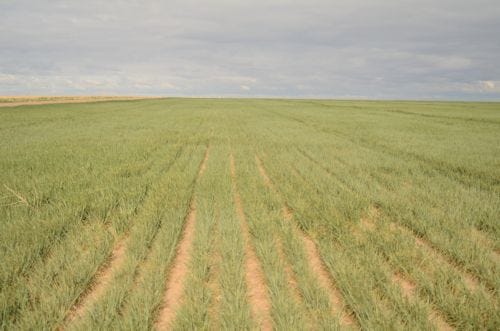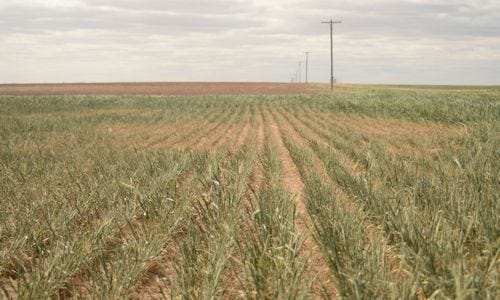
The 2014 Winter Wheat Tour wrapped up in Kansas City Thursday afternoon after 20 car groups traveled throughout Kansas, parts of southern Nebraska, and northern Oklahoma, to evaluate the 2014 hard red winter wheat crop. Out of the total 587 stops, the average calculated yield for the three days was 32.8 bushels per acre – 6.7 less than the 2013 average of 41.1 bushels per acre.

A wheat field north of Liberal in Seward County, Kansas. Soil moisture and yield calculations declined moving west toward Colby, and even more moving south toward Liberal.
As one of the tour participants this year and last year, a noticeable difference is how consistently low calculated yields were from east to west. Starting out in Manhattan, the tour meandered through north central Kansas and parts of southern Nebraska before moving into northwest Kansas and finishing day one in Colby. The first day saw calculated average of 34.7, with the highest yields in north central Kansas and southern Nebraska.
Drier conditions to the west
Crossing into the western third of Kansas, it became clear the biggest concern wasn't freeze damage from cold weather in mid-April, but drought. Yields declined slightly, and soil moisture was almost nonexistent in the western part of the state.
Drought became more pronounced moving south on day two. Some groups circled around the western tier of Kansas counties bordering Colorado. A few groups, including mine, traveled further south through northwest Oklahoma, where calculated yields were typically in the low to mid-20s, moving into the upper 20s in north central Oklahoma.

Many wheat fields in southwest Kansas and northwest Oklahoma, like this one in Beaver County, Oklahoma, had spotty stands. Calculations in northwest Oklahoma ranged from the low to mid 20s.
However, eyeball estimates and conversations with growers tell a different story – a lot of wheat heading out at 8 to 12 inches in height presents difficulty when harvesting. Some wheat, especially in northwest Oklahoma and southwest Kansas, likely won't be harvested, and we also saw a lot of wheat being grazed in northern Oklahoma.
~~~PAGE_BREAK_HERE~~~
The average for day two was 30.8 bushels per acre. Although calculated yields improved slightly to about 30 to 35 bushels per acre moving into south central Kansas, the tour also saw wheat heading out at a short height. "If in fact they get headed out and have enough rain to fill the kernels, how do you cut it with a 40-foot header?" notes Wheat Quality Council executive vice president Ben Handcock. "I couldn't imagine cutting a 40-foot swath in 12-inch wheat."
Central corridor won't be saving grace
Moving northeast from Wichita on the final day, fewer wheat is grown in the eastern part of the state. Moisture improved and yields increased slightly, but much of the crop is still in the earlier pre-flag stage. The average for the final day was 37.8 bushels per acre.

Some fields, like this one in Harper County, Oklahoma, had wheat heading out at a short height due to drought stress.
As Handcock notes, while calculated yields in western Kansas were low compared to the rest of the state, they were higher than expected. However, what saved the average last year was yields in the central corridor of the state. "What's killing us on overall yield is the central part of the state that never has a crop failure. This year, they're having one," Handcock says. "It usually makes up for low-yielding areas in the state. This year it's not going to do that."
USDA National Ag Statistics Service won't report the total amount of abandoned acres until August, but the general consensus is abandonment will likely be from 10% to 15%."They may actually harvest some rather than tear it up," Handcock says. "They aren't going to plow it up, because that's all they have to hold the ground in place. If they tear it up, there is nothing they can plant in its place."
About the Author(s)
You May Also Like






